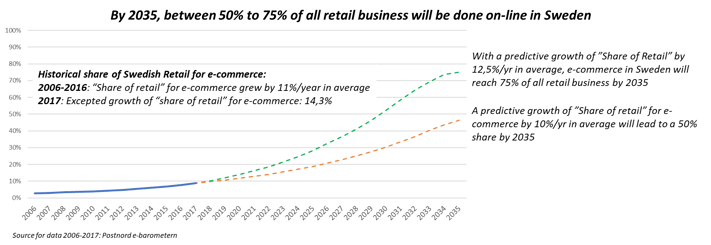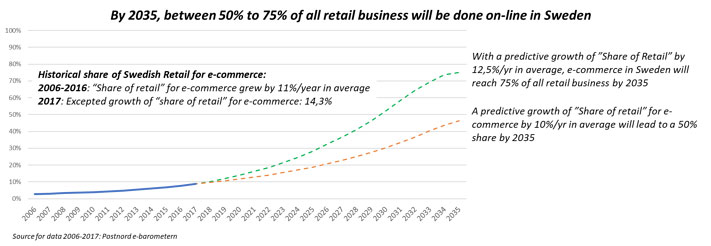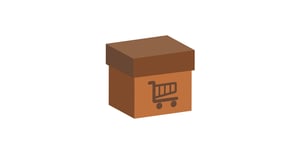It has not escaped anybody’s notice that Swedish retailers are currently struggling to define their business future and their best digital path. Which of the Swedish retailers will “bite the dust” and disappear in the paradigm shift that we are witnessing today? What end-game should Swedish retailers aim at in order to win the digital race? Let’s try to answer this question, keeping in mind that there is no “crystal ball” and that only time, and business guts, will tell.
What will Swedish retail look like in the future? Let’s look towards year 2035:
1. 2035: Most retailing occurs online
In Sweden, the “Share of Retail” happening in e-commerce has grown by 10-15 % each year since 2006. There are no signs of anything stopping this growth in the coming decades. Looking ahead, the “Share of Retail” taking place on-line by 2035 will likely end up between 50% to 75%.

2. 2035: Home delivery is a commodity
Just as we see electricity or water in our western societies, digitalization will transform many services to commodities. Services with monthly subscription such as Spotify, Netflix or Amazon Prime (already 80 million members) are leading the way in this “service commoditization”.
And this will be true for home-delivery in Sweden too. Every home will subscribe to a delivery service, pay a monthly fee and be able to order any product home-delivered within any lead-time.
3. 2035: Brands still need to meet the consumers in the physical world
Even in a purely digitalized world, brands will always have to create strong relationships with their consumers in order to keep their loyalty. From pop-up stores (like Magnum Pleasure Stores or IKEA kitchen design pop-up) to “experience” stores (like Apple stores, that generated in 2015 $5000 per square meters, more than any other brands in the U.S.), the physical stores will be a place to meet and reach consumers.
Getting advice and help, experiencing the products, and interacting with the brand will be the main drivers for consumers to visit a store. Whatever product they decide to buy while in stores will be home-delivered. No stocks will be kept in store, only demonstration products. Consumers will not choose the store they visit on rational criteria but on emotional ones: they want to get inspired.
4. 2035: Sustainability is a no-brainer
No retailers can afford a business model based solely on mass-consumption and volume purchasing anymore. According to the Swedish “Ungdomsbarometern 2017” (yearly survey among young Swedish people) 47% of all young people want to influence others by consuming in a sustainable way, and this trend will only grow.
Non-recyclable materials, “junk-products” and lack of sustainable value chains are prohibited in the eyes of the 2035 consumers. Transport is of course also based on sustainable energies.
5. 2035: There is still a demand for a basic offering
Let’s face it, even in 20 years or so, social inequalities will unfortunately not have disappeared. Even in Sweden, land of equality, both the number of households classed as rich and the number of households classed as poor grew between 2011 and 2015.
In 2035, there will still be a need for a low-price, average-quality, basic assortment and offering. Home-deliveries, even if it has become a commodity, will not be for everyone. This part of the retail market will still be very much bricks-and-mortar.
So what does that mean for Swedish retailers?
- Retailers whose business model is solely based on click-and-collect will disappear: these models only profit of a sub-optimized distribution network. When home deliveries have become a commodity, they will disappear. Companies like Webhallen, Kjell & Company or Teknikmagasinet have to find new ways to reach their customers. Either they fully switch to an e-commerce model “à la Amazon” or they must provide a much higher level of expertise and experience in stores. If not, they will disappear.
- Retailers not choosing between a clearly differentiating brand or a low-cost business model will disappear: these retailers will be caught between brand leaders and efficient “basic” competitors, and the pressure on individualization and differentiation from consumers will break their generic model into pieces. Products and store experience must be unique to make the consumers go the extra mile and give their loyalty to the retailers. “Mass-consumption” model will push away sustainability-aware consumers. While brands like ICA, Zara or Primark have a very clear positioning today, other large retailers within the food or the “main street” fashion retail industry are possible victims. They need to define a much clearer path forward for their brand and business model to survive the coming decades.
- Retailers relying only on store opening for growth will disappear: these retailers are founding their growth on a dying model. If they do not focus on increasing revenue per store, through consumer loyalty and inspirational stores, they will roll downhill and end up crashing into a wall of unprofitability. Already today several retailers seem to have issues leveraging revenue on their store openings, building up costs instead of margin.

Who will survive and who will not in the Swedish retail market remains yet to be seen, and will depend on the ability of steering committees, managing directors and the organisation to transform their company in a digitalized era. Taking the lead through a disruptive business model is a path few have taken yet in Swedish retail and it is probably the bluest of all the oceans ahead.
If you want to discuss your company’s future or the future of retailing in Sweden, do not hesitate to contact us at Centigo, or me directly.


